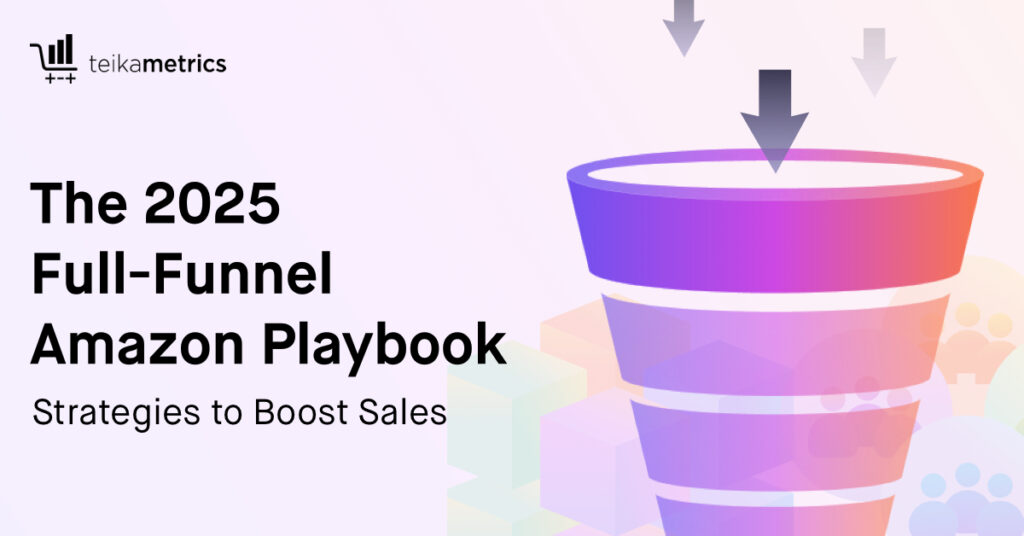Amazon sellers rely on positive reviews to keep their businesses afloat. But many sellers cut corners when it comes to product quality assurance. Sajag Agarwal, Founder and CEO of Movley, a supply chain optimization platform, joined Liz Downing for a discussion about how certain practices put Amazon sellers at risk.
Topics included:
- Why sellers should protect their products like they’re an investment
- How to reduce return rate
- How to ensure inspections are effective
- & so much more
Show Links
- Check out Movely
- Connect with Sajag Agarwal on Linkedin or Twitter
- Check out Teikametrics
- Connect with Teikametrics on Twitter or LinkedIn
Watch the Replay
Key Teika-Ways
06:54 – Protect your products like they’re an investment
Ensuring that your products are inspected correctly is an essential part of providing a good customer experience and finding success on Amazon.
“If the inspector doesn’t truly understand your products or how to inspect them, even the best inspector can pass a defective batch of products. But when it comes down to the customer journey, I think back to what Liz was saying. It’s really important to emphasize the customer journey on Amazon especially as you get more and more brands in the market. The way you’re competing in the market is through reviews. It’s through customer testimonials and that’s what’s driving your rankings, your running ads create those rankings, and it’s very important to protect your listing on an investment front because your listing is essentially an investment. So once you put in money into your listing and you’ve spent money ranking it, building your keywords, optimizing it, running ads to your listing, getting the buy box. If you have other distributors on listing as well, once you’ve invested all that money, quality control is something that a lot of sellers skimp on as well as advertising and things like that. And then that’s when you start having issues, when you start having negative reviews, you have returns and start having problems with your products.”
09:41 – Keeping product quality high reduces returns
Returns eat into your profit margins for multiple sales afterwards. Good inspections can cut out the returns from defective products.
“20% of e-commerce returns are generally due to defective products. So product quality control, things like that. So if you’re able to eliminate product quality control problems from your listing, 20% decline on your return rate pretty easily. And that tabulates to about $41 billion in profits that are lost each year, just due to a lack of returns on online purchases and $82 million of profits are lost each year due to faulty or defective products. What it really comes down to is, it’s actually $82 billion. I got the mil and bil mixed up, but when it comes down to an overall kind of rundown, as far as kind of how that works, especially when you have like defective products and file for return, that return can eat up sales and your profits for multiple sales. So for example, on our products, we had about a $3-4 profit margin. We were selling low-cost products and one return unit would actually eat up profits from three to four sales.”
12:04 – Amazon is the online reputation for your product
Unsatisfied customers are more likely to leave a review than a satisfied one. Those reviews create the online reputation for your product, even if you sell in other marketplaces.
“So say for example, you have a customer who’s unsatisfied with the product. They’re 10 times more likely to leave a review. And based on the general research, it takes on average 40 good reviews to undo the damage with one bad review. And that’s huge. So when you’re selling on Amazon and things like that, for a lot of brands that are also selling in retail, so if you’re selling at Walmart, you sell at Target, a lot of shoppers go online and they go on Amazon to look at reviews, even if they buy that product at Best Buy, they buy that product at Walmart. So Amazon is almost like an online reputation for your company, for your specific products. And that’s something that’s completely out of your control. That you have no way of controlling taking down or anything like that. And even contacting those customers because Amazon makes it very difficult to do that. So it’s incredibly important to protect yourself against those bad reviews and those returns.”
14:29 – Don’t falsify your product descriptions
Don’t inflate your product features or use the wrong keywords. That may attract more sales, but you’ll also get more returns and bad reviews that will hurt you.
“A lot of sellers when they first start out their business, especially in launching, they like to inflate their product features and things like that. And that can lead to a lot of problems. So, you know, 20% of returns are due to defective products, but the other 80% of returns, a big portion of that is due to undescribed products or products that customers were not satisfied with because they received inaccurate information on the listing. So for example, this applies to ads as well. So we sold products with certain lengths on Amazon. So with sort of some products our lengths were five feet and we would run keywords. Like, Hey, 10 feet long product or three-foot long product and customers bought those products, didn’t do any due diligence and they would write to the return reason. I thought the product was three feet. I thought the product was 10 feet. And did not actually do the diligence because we were running advertising on the wrong keywords. And that also applies on the other side as well when you have the listing optimization, because if you inflate your features too much and it’s a little bit too much over-promising on your product, when customers receive those products that encourages them to return and they’re not as satisfied.”
16:15 – Control for defect rate
If you don’t, you’ll end up with a large amount of bad reviews that offset any positive ones you get.
“A lot of customers they’re like, Hey, you know, if I have a 1% defect rate or 2% defect rate it’s fine, and this is something we see on inspections, and this is kind of where we pulled this data from. So a lot of customers, when they do inspections, they’re like, Hey, you know, I’m going to inspect 30, 40, 50 units out of a thousand. It should be good enough. And try to cut costs on inspections. Now, the thing is that you can use the level system on AQL, which is where you want to start. You have level one, level two, level three. But say for example, you have a thousand units and you want to test 80 units. There’s kind of two ways to look at it. First with the level system, which is a little bit more complex a statistical model, which I’ll kind of dive into a little bit later on how that works and how that can influence your defect rate and your product reviews. But if you’re only testing 80 products and you’re testing for a 1% defect rate, They’re not going to be able to find products. Because if you have one in a hundred that are defective and they only test 80, it’s a pretty decent chance you don’t find that one defective unit when you check 80 units. So it’s really important to really check the products and make sure you’re controlling for defect rate.”
21:58 – Marketplace sellers have it hardest
Other sellers like brick and mortar and online retail don’t deal with returns, bad reviews, and competitive pricing the way marketplace sellers do.
“Marketplace sellers really have it the hardest because of those negative reviews and because of those returns and because of those metrics that those marketplaces like Amazon track and put on, it makes a huge difference in the way the marketplace operates and how your business needs to run. So all the supply chain advice you can get online, that’s really good, but you want to always do things on the side of caution and doing things a lot tighter than what you would expect from the advice you get online. And that applies to really anything on the supply chain side that we’ve seen for marketplace sellers, whether it’s negotiations, your pricing is a lot more, a lot harder because it’s a lot more price competitive online. So buying orders, buying products in China, wherever you’re buying them at wherever you’re sourcing, you need to be more careful there. You need to be more careful with your supply chain through quality control.”
25:47 – Prioritize supply chain management
Many things can go wrong along the way and create a waterfall of issues down the line if you don’t work to manage your supply chain and keep items in stock and keep an eye on inventory. The sellers who survived the pandemic had this in place.
“It’s incredibly important that supply chain is prioritized there because if you have shipping times and getting it to the warehouse, it’s more time. If it’s delayed, if there’s any delays in the process, there’s so many points of contact in the process. If there’s delays, you can lose the buy box, you can lose your listing. If you have no active sellers on your listing, you’re not running ads, your rankings can impact, your reviews can impact as well. So a lot of times, especially when you’re launching a product, if you do have negative reviews is due to the product breaking or problems with the product. And a lot of those come 30, 40, 50, 60, 80, 180 days out, you can have negative reviews coming out from the sale six months later. And when your product goes out of stock, you’re not only losing search relevancy losses, not only losing your optimization on the listing, your ads performance, and you have to reset that. You are also affecting your product reviews. Because if they’re out of stock for three, four months and you had a bad order, or you had some problems with your product, now, all of a sudden for three, four months, we’re only getting negative reviews from past sales if you’re not getting positive reviews for new sales.”
28:32 – Give customers a way to contact you
Amazon no longer lets you respond to reviews, but you can use branding or smart packaging to funnel complaints directly to you so you can resolve issues before they become bad reviews. Customers actually prefer that.
“One of the things we’ve seen really work really well is investing in branding. And that’s another corner you can really cut, especially when you’re launching a business. Like, Hey, I don’t need a website, I don’t need a Facebook profile, I don’t need a Twitter profile. My customer support email can just be through Amazon contact the seller. I don’t really need an email, things like that. And I don’t need a website. A lot of times you don’t need a website for selling products, but you want a website for customers to reach you because those same customers that leave a review and, you’d be surprised, a decent portion of them would actually rather contact your company and ask for you to resolve that before they leave that negative review. But if you make it very difficult to reach out and to resolve that issue, or you don’t tell customers there’s a team behind that, then it makes it very difficult. So what most Amazon sellers do or Amazon buyers is they go through the Amazon platform, because they’re used to Amazon branding, the Amazon systems, but if you have in your packaging, and a lot of very successful Amazon brands do this where it’s just a very simple thing, it could be like a happy and not happy card.”
35:54 – Aim for readability
Don’t keyword stuff. Aim for readability and building a trustworthy brand instead.
“It goes back into the branding bucket of Hey, you want a tone of voice, you want a feel, you want something that customers can align to because at the end of the day the question is, even if you sell your business, long-term you want to exit, you want to hire multiples, you want to build a brand behind your products. You don’t want to just be another Amazon seller with a no-name brand. So having that tone of voice, having that readability, it creates trust, especially when you’re competing with a lot of international sellers. Especially on the marketing side I notice a lot of listings are in broken English or a little bit difficult. So having a English listing in native English that really is readable adds a lot of trust for buyers, because at the end of the day, they want to know if they have a problem with the product, they’re going to receive a support that they like and they can understand. So having that readability is very, very important and it creates trust with the customers because once they’ve reached your product page, they’re already sold on your product.”
50:33 – It all comes down to sample size
You need to make sure that your sample size for inspections is statistically significant and that it accounts for the defect rate.
“You want to look at it from the perspective of how many units do I need to check to have a statistically significant result, less so of how many units on a percentage should I test of the entire order? So if you have like 10 units and you test 10% of the product, you have to test one product, that’s not really going to be a step to getting a result because that one product could be great and your eight other products in that could be defective. If you have a hundred products and you test 10 percent of the units, kind of the same thing, you’re testing one out of 10, you could still have a bunch of defects. You can’t really estimate for that. So what ISO 2859 basically looks at is what is the least number of units you can test while still being statistically significant, and level one is the lowest statistical level quantity and level three is the highest. And that’s generally what we use as a baseline for inspections and that’s what you want to use as a baseline for inspections as well. So for a thousand units, level one is 32, pretty low, but it’s statistically significant. Level two is 80 and level three is 125. Now the next thing you want to look at is, based on a defect control rate, if you’re trying to account for a 1% defect rate or a 2% defect rate, you need to test enough units in whatever level you choose or even go above and beyond that, to make sure that you’re testing for that appropriate defect rate.”





